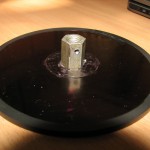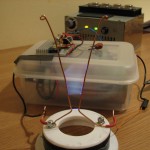Following my various high voltage experiments, the need for high voltage components became clear. Unfortunately these are among the most expensive parts.
So I’ve decided to try building some of them myself – in this case a high voltage capacitor.
Using plastic foil (from various shopping bags) and aluminum foil, the only other ingredient required was patience: in cutting everything with the scissors, and putting the parts together using tape.
I’ve used two pieces of 30cmX40cm plastic foil, cut into 3 equal longitudinal parts (10cmX40cm). Some smaller stripes of aluminum foil (to avoid arc overs), say 7cm x 37cm.
The 2 plastic foils were used as one single ticker foil, and they served as dielectric. Making some initial measurements (a must do!), showed they can withstand 10KV without puncturing.
So one layer of dielectric, one of aluminum foil, another of of dielectric, and so on, everything put together in this topology:
======= (dielectric)
——- (A)
======= (dielectric)
——- (B)
======= (dielectric)
——- (A)
======= (dielectric)
——- (B)
======= (dielectric)
——- (A)
======= (dielectric)
——- (B)
======= (dielectric)
The 3 A’s are connected together using well insulated wire, and so are the B’s. Basically at the end you need to connect one capacitor wire to A and another to B. I’ve used red – high voltage wires.
Then roll everything together to minimize the used space, and try to compress them as good as possible, since tiny air spaces can affect the capacitance. Even so, my homemade capacitor had variable capacitance on the pressure applied to it.
See this video for more details:
Cheers,
Radu Motisan



what does dielectric means ?
@bogdan, see:
http://lmgtfy.com/?q=wikipedia+dielectric
I am looking at a homemade 12 or 24Vdc capacitor bank that can be used in conjunction with solar panels. The preliminary plan is to use 18 inch wide food grade aluminum foil and brown paper like they use for pole mounted step-down transformers. Two or three finished roles would be installed inside a sealed 55 gallon polyethylene drum and purged with dry argon gas. I may use mineral oil once the moisture has been pulled out. I need to address the controlled charging and discharge of five or ten of these drums wired in parallel. I’m trying to emulate the power system the LED flash light I have is charged by shaking the internal magnetic.
Hi Richard ,
Quite an interesting plan you’ve got there! May I ask what is the exact function of the capacitors in your system, I am not familiar with the solar panel systems.
I think the most difficult part will be to roll everything together (the foil and the brown paper) as tight as possible, maybe with some machine designed for this purpose, I’m not sure; the brown paper can be thin, for 12-24V you don’t need any special dielectric.
Please post some pictures when you have it, I’m interested in seeing it. Good luck
Am observat in filmuletul tau ca a cedat condensatorul si ma gandeam dak pot sa pun o foie de hartie intre cele doua straturi de plastic? Sau sa folosesc un plastic mai gros?
—EN—
in your film I’ve seen the capacitor has failed, and I was wondering is I should add paper between the two plastic layers? Or should I use ticker plastic?
@chupy: Uite acum folosesc 3 condensatori homemade pusi in paralel. Fiecare are cam 5nF si un dielectric testat sa reziste la 10KV. Am folosit banda izolatoare din acea groasa pt impachetat, si am pus 3 sau 4 straturi, apoi folie de aluminiu taiata panglica, astfel incat sa ramana in interiorul izolatorului cu vreo 7 mm de fiecare parte. Am rulat totul si am obtinut un condensator compact, f rezistent. Dar iti dai seama, ca ai o multime de variante. Totusi, hartie nu as folosi. Vezi la magazinele de profil, folie pt solar, cred ca ar fi cea mai buna alegere, si o tai cum vrei ca e mare.
—EN—
No I’m using 3 homemade capacitors in parallel. Each has aprox 5nF and a dielectric tested to hold up to 10Kv. I’ve used insulater band for packaging, in 3 or 4 layers then aluminum foil cut so that it would be smaller then the insulator with 7mm on each side. Rolled everything together and got a nice compact, robust capacitor. But as you can realize, there are many variants. Check at local stores for Green House foil.
Ms mult 😀 o sa incerc cu folie pt solar:)
—EN—
Thanks, I’ll try the Green House Foil.
I’m making a big tesla coil and I have to put a 8kV 45 – 60 nF capacitor, can I use a capacitor like this?
Sure you can. Easy to make one as well, and it won’t fail that easy, assuming you are using a quality dielectric (maybe glass).
hi everybody
this marx generatör is my university project. And i am going to build it. but i don’t know how do i do it. if anybody send me this (marx generatör) circuit shema , equipments and aquipments values, and similasions and other documents i will be very happy and graduate..and i need values of capacitors, resistors and etc.
thanks for now
my e mail is : onurulusoy@hotmail.com
thank your
Capacitors are used in various ways, with some of them designed for high-frequency circuits. Others are made specifically to handle larger amounts of voltage. Capacitors of various sizes and designs are used to tune radios, in clocks and electronic counting devices, in sensitive medical equipment and even in cars and electric vehicles.
How about this: http://www.youtube.com/watch?feature=player_embedded&v=_Fs8UooiYKs
Trucaje moshule, pe final se vede clar ca e facut trucajul ciobaneste.
moshule, de ce ar fi trucaj? stii ce e un condensator si cum functioneaza? daca nu, instruieste-te inainte de a da cu parerea, asa… ciobaneste 🙂
Pingback: What kind of capacitor could build up, and maintain a charge acquired from lightning? – Config9.com